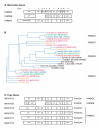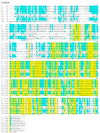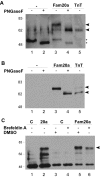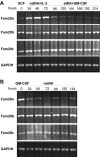FAM20: an evolutionarily conserved family of secreted proteins expressed in hematopoietic cells
- PMID: 15676076
- PMCID: PMC548683
- DOI: 10.1186/1471-2164-6-11
FAM20: an evolutionarily conserved family of secreted proteins expressed in hematopoietic cells
Abstract
Background: Hematopoiesis is a complex developmental process controlled by a large number of factors that regulate stem cell renewal, lineage commitment and differentiation. Secreted proteins, including the hematopoietic growth factors, play critical roles in these processes and have important biological and clinical significance. We have employed representational difference analysis to identify genes that are differentially expressed during experimentally induced myeloid differentiation in the murine EML hematopoietic stem cell line.
Results: One identified clone encoded a previously unidentified protein of 541 amino acids that contains an amino terminal signal sequence but no other characterized domains. This protein is a member of family of related proteins that has been named family with sequence similarity 20 (FAM20) with three members (FAM20A, FAM20B and FAM20C) in mammals. Evolutionary comparisons revealed the existence of a single FAM20 gene in the simple vertebrate Ciona intestinalis and the invertebrate worm Caenorhabditis elegans and two genes in two insect species, Drosophila melanogaster and Anopheles gambiae. Six FAM20 family members were identified in the genome of the pufferfish, Fugu rubripes and five members in the zebrafish, Danio rerio. The mouse Fam20a protein was ectopically expressed in a mammalian cell line and found to be a bona fide secreted protein and efficient secretion was dependent on the integrity of the signal sequence. Expression analysis revealed that the Fam20a gene was indeed differentially expressed during hematopoietic differentiation and that the other two family members (Fam20b and Fam20c) were also expressed during hematcpoiesis but that their mRNA levels did not vary significantly. Likewise FAM20A was expressed in more limited set of human tissues than the other two family members.
Conclusions: The FAM20 family represents a new family of secreted proteins with potential functions in regulating differentiation and function of hematopoietic and other tissues. The Fam20a mRNA was only expressed during early stages of hematopoietic development and may play a role in lineage commitment or proliferation. The expansion in gene number in different species suggests that the family has evolved as a result of several gene duplication events that have occurred in both vertebrates and invertebrates.
Figures











References
-
- Ogawa M. Hematopoiesis. J Allergy Clin Immunol. 1994;94:645–650. - PubMed
-
- Metcalf D. Hematopoietic regulators: redundancy or subtlety? Blood. 1993;82:3515–3523. - PubMed
-
- Tenen DG, Hromas R, Licht JD, Zhang DE. Transcription factors, normal myeloid development, and leukemia. Blood. 1997;90:489–519. - PubMed
-
- Tsai S, Bartelmez S, Sitnicka E, Collins S. Lymphohematopoietic progenitors immortalized by a retroviral vector harboring a dominant-negative retinoic acid receptor can recapitulate lymphoid, myeloid, and erythroid development. Genes Dev. 1994;8:2831–2841. - PubMed
Publication types
MeSH terms
Substances
LinkOut - more resources
Full Text Sources
Other Literature Sources
Medical
Molecular Biology Databases

